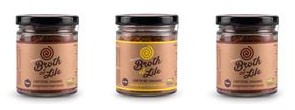
Until recently, I hadn’t heard of Diverticulitis, let alone know what it was or how to treat it. It was only when a dear friend started complaining about stomach cramps and nausea and was eventually diagnosed [1] with the colon disease, that I began to look into it.
The abdominal pain and cramping that my friend suffered in the lead up to his diagnosis was so intense that he ended up in the emergency department of our local hospital. Flashbacks of my own experience with appendicitis came to the fore. Although hugely different circumstances, as it turns out, both ailments can be, under medical supervision, treated with… Drum roll please... Bone Broth!
As a result of my friend’s diagnosis and advice from physicians that he adjust his diet quite drastically [2], I went into research mode, determined to help him be comfortable again.
What is Diverticulitis
I quickly discovered that Diverticulitis is a painful disturbance of the digestive tract and is common in people over the age of 40. It occurs when the diverticula, the small sacs that line the digestive tract, become infected. When the diverticula, which are ordinarily found in the colon, develop in the gastrointestinal tract and bacteria forms, they become inflamed. Amazingly, the cause of such inflammation and infection is unknown. It could be that pressure on the pockets or sacs results in a tear of the intestinal wall. Doctors and scientists are even unsure as to why the diverticula form [3] in the first place. One theory is that high pressure inside the colon pushes against vulnerable sections of the colon wall. There has also been a lot of research around low fibre/poor diets, aging, lack of exercise and obesity being contributing factors.
While the disease itself seems to be cloaked in uncertainty, one thing the medical world is quite certain about is treatment. This does unfortunately, in this case, throw the saying, ‘treat the cause not the symptoms’ clear out the proverbial window.
What are the Symptoms?
Like any disease, diverticulitis has some key indicators to look out for.
These include;
- Severe abdominal pain
- Cramping
- Lower abdomen tenderness
- Nausea
- Changed bowel habits
- Fever
- Chills
How to Treat It
Unfortunately, once you have Diverticulitis, it will always be with you. Whether you have consistent symptoms or your symptoms come and go in waves, treating a diverticulitis flare up can often be as simple as adjusting your diet [4]. Some flare ups may require the assistance of antibiotics [5] (along with dietary adjustments) or even surgery to help the patient recover but for mild cases, diet can solve the immediate problem.
One of the most important elements of cleaning and recovery is bone broth. We already know that bone broth assists with joint health, can help skin elasticity, is jam packed full of the vitamins and nutrients our bodies need to function at their best, boosts our immunity and our ability to fight colds and flu and is used to treat leaky gut syndrome. It makes perfect sense then, that our favourite gelatin and collagen packed liquid is also used to heal the digestive tract when it is overcome by the symptoms of diverticulitis.
The rule here also applies to foods being easy to digest. Bone broth is an easily digestible way to get stacks of vitamins and nutrients into your system. It’s also recommended that patients consume grated, steamed and pureed fruits and vegetables. Freshly squeezed fruit and veggie juices are also ideal.
After you’ve flushed your system with bone broth, purees and juices, fibre rich foods are the way to go. Although the cause is still a mystery, there are some scientists and medical professionals who suspect that a fibre rich diet may well prevent the disease’s onset to begin with.
For my friend, although a life-long burden, his diverticulitis diagnosis came as something of a relief. Yes, the flare ups were incredibly painful, yes, he would have it for life but the fact that it could be treated with diet adjustments was a massive bonus. He is the kind of guy who will always look for a silver lining and those people are ones to be inspired by. In his opinion, he is now eating better than he ever has before.
For an in-depth guide to the diverticulitis diet, click here.
To order your certified organic, dehydrated bone broth and get the healing process underway, click here.
References
[1] https://www.ncbi.nlm.nih.gov/pubmedhealth/PMH0025271/
Acute colonic diverticulitis: a systematic review of diagnostic accuracy
Review published: 2007.
Bibliographic details: Liljegren G, Chabok A, Wickbom M, Smedh K, Nilsson K.
[2] https://www.ncbi.nlm.nih.gov/pubmed/25938392
Dietary prevention and treatment of diverticular disease of the colon
Pol Merkur Lekarski. 2015 Apr;38(226):228-32.
[3] https://www.webmd.com/digestive-disorders/tc/diverticulitis-cause
[4] https://www.health.qld.gov.au/__data/assets/pdf_file/0035/154889/gastro_diverticular.pdf
[5] https://www.ncbi.nlm.nih.gov/pubmedhealth/PMH0049728/
Antibiotics for uncomplicated diverticulitis
Cochrane Database of Systematic Reviews: Plain Language Summaries [Internet].
First published: November 14, 2012.

